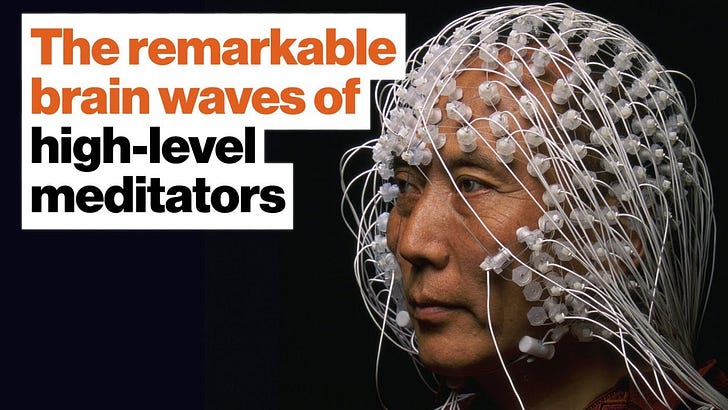Buddhist meditation practices that encourage feelings that promote peace of mind and happiness.
When I was a teenager, I completely rejected the Roman Catholic Church and all its teachings. With no lingering doubts, I believed I was a hardcore atheist.
This break from my past allowed me to freely explore other religious and spiritual traditions without fear that God would hate me and punish me with eternal damnation.

I was drawn to mysticism and philosophy because I believed the answers to life’s most important questions must be accessible to the human mind, and if I could discover them, I could enjoy peace and everlasting happiness.
I chased the Holy Grail of “Enlightenment,” which I believed was a single fact or discovery that would magically wipe away all emotional hardship in an instant, like turning on a light bulb in a darkened room.
I read books on philosophy, comparative religion, hip texts on New Age spirituality, dangled crystals, read chakras, and imagined myself a spiritual person. I wasn’t as spiritually advanced as I imagined. Reality has a way of shattering even the strongest delusions of grandeur.
Pride and Arrogance, the Price for Being Gifted
Along the way, I encountered a wide variety of religious traditions and learned many meditation techniques. This turned to my advantage.

I learned about Vajrayāna Buddhism, prevalent in Tibet, and its focus on object meditation.
Learning about object meditation planted a seed, but that seed didn’t sprout and grow until I watered it with continuous practice.
Practice is the key.
Without practice, spiritual concepts linger on the surface and fail to penetrate deeply into the heart and mind. This is why so few who seek spiritual enlightenment actually find it.
Information is not enough. This isn’t anything someone can learn intellectually that will liberate them.
In Tibetan Buddhist Lamrim teachings, object meditation refers to the practice of single-pointed concentration on a specific object or theme to develop mindfulness, concentration, and insight.
They call it object meditation, but one doesn’t focus their attention on things. The “object” of meditation is a virtue, or more specifically, the feelings that arise when thinking about virtue.
In meditations, one starts with contemplation, which is essentially thinking about concepts proven to generate virtuous feelings. When virtuous feelings arise, one holds onto those feelings for as long as possible, hours if one has the concentration for it.
If meditators lose the feeling, they return to the contemplation, generate the feeling again, and then hold it.
In this tradition, one becomes well-practiced at generating and holding virtuous feelings in one’s heart.

What is Virtue?
Western philosophers elaborate on what constitutes virtue and how one should live. Vajrayāna Buddhists have a much simpler outlook.
A virtuous object is one that causes us to develop a peaceful mind when we concentrate on it.
If we concentrate on an object that disturbs our mind, like anger, jealousy, or attachment, then the object is non-virtuous.
The entire point of meditation in the Vajrayāna tradition is to attain peace of mind.
It works!
When my mind is peaceful, I feel happy.
It isn’t complicated.
It doesn’t need to be.
Connections and Corrections
I’ve often wondered why object meditation works when other methods seem to fail or work so slowly that progress is painfully slow.
It isn’t a subject that lends itself to rigorous scientific study to prove exactly how it works, though some scientists are working in this area.
The Advantages of Meditation as Documented by Leading Scientists

There is a physical, identifiable process in the brain that separates experienced meditators from those who are not as experienced. Very experienced meditators report feelings of openness, eagerness, and lack of preconceptions when experiencing life, as if everything is new and fresh.
My Unverifiable, Subjective Observations
Consciousness and subjective experience are very difficult to study. By their nature, subjective experiences can’t be shared or verified by others. Scientists can’t know What it’s like to be a bat or another human being.
That doesn’t mean these experiences can’t be described. Further, when these experiences and realizations are genuine, the person’s behavior, demeanor, and even outward appearance can change to reflect their inner state.
For example, in the posting above, I discuss how scientists identified Gamma waves in the brainwave patterns of experienced meditators, particularly when they are asked to contemplate virtuous objects.
We can’t know what the meditator experiences, but based on the fact they exhibit an uncommon brainwave state, on command, we know they are experiencing something out of the ordinary.
My observation is that the mind works like a powerful serial processor, thinking and feeling countless different things simultaneously.
The conscious stream of thoughts is produced by your attention jumping from one thought to another while ignoring the rest, just like picking out a single conversation in a group at a raucous party.

My evidence is something you can easily verify for yourself. Attempt to stop thinking and feeling. If you are a thinker and not merely an observer, you should be able to stop thinking on demand. Go ahead and try and see what happens.
Very experienced meditators can learn to suppress thoughts for a time. I’ve tried. But success in the endeavor requires a great deal of concentration, and quiet thoughts generally sneak in anyway. I used to get congratulatory thoughts from the peanut gallery telling me how good I was at not thinking!

I might have continued with the practice if I had found any lasting peace there, but suppression is not liberation, and the moment concentration relaxes, all the disturbing thoughts flood back in.
The virtuous circle
The mind excels at constructing systems of belief. A durable worldview is the result of constructing a large and supportive belief system without contradiction or flimsy circular arguments.
The various thoughts and feelings supporting a worldview are interrelated in a complex web where each thought and feeling interacts with many others.
The mind has error-correcting mechanisms to weed out contradictory thoughts and feelings, but these are not foolproof, and people can override their incompatible and hypocritical thoughts with willful ignorance.
Willful ignorance is the playground of charlatans, false prophets, politicians, and biased news media outlets. If you want a humous illustration of how it works, watch the Saturday Night Live skit, Don’t Buy Stuff You Can’t Afford. As a bonus, you will learn everything you need to know about managing money.
With willful ignorance, people can sustain delusions indefinitely, leading to mixed feelings and disturbed patterns of thought.
People who employ willful ignorance to sustain their worldview may appear peaceful, but whenever they bump up against those instances when their worldview is incongruous with reality, they become very disturbed.
Observe any religious fundamentalist or political partisan, and you will see both heavy doses of willful ignorance and the extreme mental disturbance of the many incongruities.
Correcting Errors, Changing Minds
It takes desire, concentration, and time to find and correct these incompatible thoughts and feelings and reconcile them with reality.
Object meditation is the process of holding a virtuous thought up to the light of mental and emotional processing to see where the light fails to shine through.
Wherever one finds a thought or a feeling that is inconsistent with virtue, it can be corrected with focused concentration or additional contemplation.
So how does that theory work in practice? Let me provide an example.
At one point in my practice, I was working with pride and compassion, and I came across a homeless man lying on the sidewalk, rocking from side to side. I observed my mind to see what my reactions were.

I felt compassion for the man’s suffering; in fact, it was quite powerful, but I also found other thoughts that were not quite so virtuous.
I wondered what his failings were that brought him to that state as if he deserved to be abandoned on the street, unattended, alone, forsaken, and forgotten. It was an emotional defense mechanism I developed to squelch compassion.
I reasoned some social workers must be aware of this man’s condition and ensure he obtained some minimum level of care. This was another emotional defense mechanism to relieve me of any responsibility to act on his behalf.
I decided I couldn’t save the world so I couldn’t do anything for him either. While that was true, it wasn’t coming from my wisdom; it came from a place of avoidance, a desire to shut down the feeling of compassion that was making me uncomfortable.
Object meditation on this man and his plight forced me to look at all my reactions to him and people like him and see those reactions for what they were. It wasn’t wisdom. It was self-protection disguised as wisdom.

Over time, and with many more hours of meditation, I became more sensitive to my actions and reactions. They became less automatic, and more the result of careful consideration, feeling, and choices informed by wisdom.
That is the power of object meditation. If the desire is there to focus concentration on virtues like compassion, all errors in thinking can be exposed, and with further meditation, corrected. With enough time, even the hardest heart can be transformed.

How to Practice Object Meditation
Object meditation begins with selecting a suitable meditation object. Common objects include the breath, a visualized image of a deity or a Buddha, a mantra (repeated sound or phrase), a physical object (e.g., a pebble or a candle flame), or a specific topic or thought (e.g., loving-kindness or impermanence).
The practice has three steps:
- Consider the words of instruction for contemplation. Most Lamrim meditations carry specific instructions designed to elicit feelings. The feelings are the object of the meditation, not the words of contemplation.
- Once the virtuous feeling arises, practitioners focus their attention on the chosen virtuous object, bringing their mind back to it whenever it wanders.
- If the feeling is lost, the practitioner returns to the contemplation, generates the feeling anew, and focuses attention on the feeling.
There is a tendency to focus too much attention on the contemplation. That is a distraction. Contemplation is primarily a tool for generating virtuous feelings. Holding the feeling doesn’t require continuous contemplation, like focusing on a mantra.
At times, returning to the contemplation can be helpful to consider other aspects of the virtuous object and explore its nuances, but the feeling itself is what provides the purifying aspects of the meditation.
Object meditation also serves to further develop concentration (shamatha). Through consistent practice, concentration deepens, leading to a calm and tranquil mind.
Object meditation typically progresses through stages of development. Initially, the focus may be on stabilizing attention. As concentration deepens, meditators may experience greater clarity, calmness, and insights into the nature of the mind.

Lamrim teachings encourage practitioners to integrate object meditation into daily life. Mindfulness and awareness cultivated during meditation can be applied to daily activities, promoting a more mindful and compassionate way of living.
Object meditation is a means of purifying the mind from negative thoughts and emotions, promoting positive qualities, and ultimately transforming the practitioner’s consciousness.
While object meditation can yield immediate benefits in terms of calmness and clarity of mind, it is also considered a vital component of the path to enlightenment (Buddhahood). Through deep meditation and insight, practitioners can ultimately realize the true nature of reality and attain liberation from suffering.

